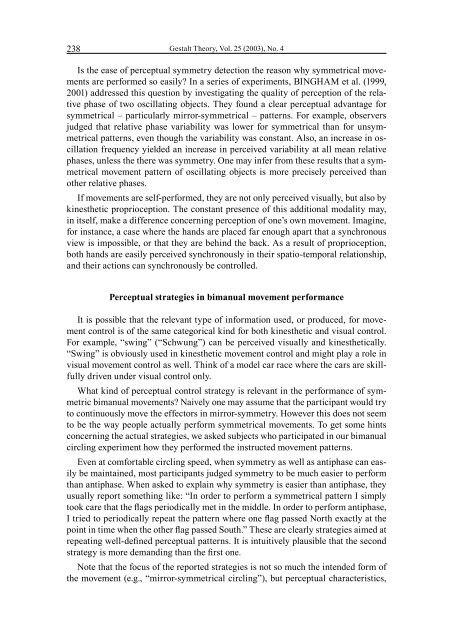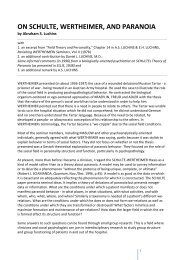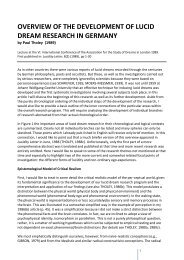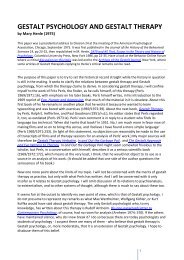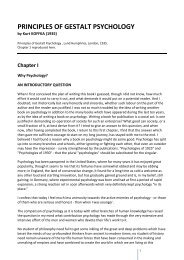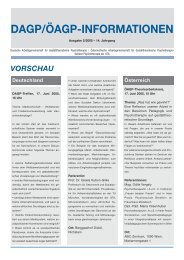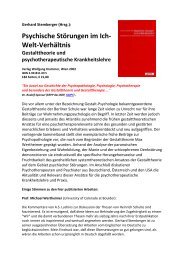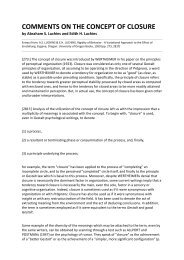Gestalt Factors in Human Movement Coordination - Society for ...
Gestalt Factors in Human Movement Coordination - Society for ...
Gestalt Factors in Human Movement Coordination - Society for ...
Create successful ePaper yourself
Turn your PDF publications into a flip-book with our unique Google optimized e-Paper software.
238<strong>Gestalt</strong> Theory, Vol. 25 (2003), No. 4Is the ease of perceptual symmetry detection the reason why symmetrical movementsare per<strong>for</strong>med so easily? In a series of experiments, BINGHAM et al. (1999,2001) addressed this question by <strong>in</strong>vestigat<strong>in</strong>g the quality of perception of the relativephase of two oscillat<strong>in</strong>g objects. They found a clear perceptual advantage <strong>for</strong>symmetrical – particularly mirror-symmetrical – patterns. For example, observersjudged that relative phase variability was lower <strong>for</strong> symmetrical than <strong>for</strong> unsymmetricalpatterns, even though the variability was constant. Also, an <strong>in</strong>crease <strong>in</strong> oscillationfrequency yielded an <strong>in</strong>crease <strong>in</strong> perceived variability at all mean relativephases, unless the there was symmetry. One may <strong>in</strong>fer from these results that a symmetricalmovement pattern of oscillat<strong>in</strong>g objects is more precisely perceived thanother relative phases.If movements are self-per<strong>for</strong>med, they are not only perceived visually, but also byk<strong>in</strong>esthetic proprioception. The constant presence of this additional modality may,<strong>in</strong> itself, make a difference concern<strong>in</strong>g perception of one’s own movement. Imag<strong>in</strong>e,<strong>for</strong> <strong>in</strong>stance, a case where the hands are placed far enough apart that a synchronousview is impossible, or that they are beh<strong>in</strong>d the back. As a result of proprioception,both hands are easily perceived synchronously <strong>in</strong> their spatio-temporal relationship,and their actions can synchronously be controlled.Perceptual strategies <strong>in</strong> bimanual movement per<strong>for</strong>manceIt is possible that the relevant type of <strong>in</strong><strong>for</strong>mation used, or produced, <strong>for</strong> movementcontrol is of the same categorical k<strong>in</strong>d <strong>for</strong> both k<strong>in</strong>esthetic and visual control.For example, “sw<strong>in</strong>g” (“Schwung”) can be perceived visually and k<strong>in</strong>esthetically.“Sw<strong>in</strong>g” is obviously used <strong>in</strong> k<strong>in</strong>esthetic movement control and might play a role <strong>in</strong>visual movement control as well. Th<strong>in</strong>k of a model car race where the cars are skillfullydriven under visual control only.What k<strong>in</strong>d of perceptual control strategy is relevant <strong>in</strong> the per<strong>for</strong>mance of symmetricbimanual movements? Naively one may assume that the participant would tryto cont<strong>in</strong>uously move the effectors <strong>in</strong> mirror-symmetry. However this does not seemto be the way people actually per<strong>for</strong>m symmetrical movements. To get some h<strong>in</strong>tsconcern<strong>in</strong>g the actual strategies, we asked subjects who participated <strong>in</strong> our bimanualcircl<strong>in</strong>g experiment how they per<strong>for</strong>med the <strong>in</strong>structed movement patterns.Even at com<strong>for</strong>table circl<strong>in</strong>g speed, when symmetry as well as antiphase can easilybe ma<strong>in</strong>ta<strong>in</strong>ed, most participants judged symmetry to be much easier to per<strong>for</strong>mthan antiphase. When asked to expla<strong>in</strong> why symmetry is easier than antiphase, theyusually report someth<strong>in</strong>g like: “In order to per<strong>for</strong>m a symmetrical pattern I simplytook care that the flags periodically met <strong>in</strong> the middle. In order to per<strong>for</strong>m antiphase,I tried to periodically repeat the pattern where one flag passed North exactly at thepo<strong>in</strong>t <strong>in</strong> time when the other flag passed South.” These are clearly strategies aimed atrepeat<strong>in</strong>g well-def<strong>in</strong>ed perceptual patterns. It is <strong>in</strong>tuitively plausible that the secondstrategy is more demand<strong>in</strong>g than the first one.Note that the focus of the reported strategies is not so much the <strong>in</strong>tended <strong>for</strong>m ofthe movement (e.g., “mirror-symmetrical circl<strong>in</strong>g”), but perceptual characteristics,


